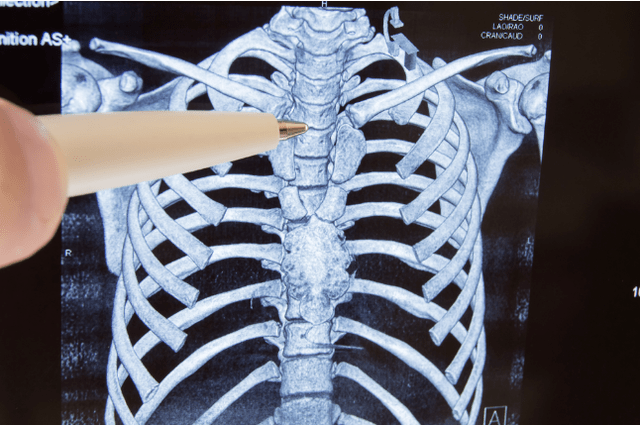Osteochondrosis is a spinal disease in which the intervertebral disc (and so on the body of the vertebra, joints and ligaments) loses their ability to function normal.

The cause of osteochondrosis is now considered a set of factors that affect the spine during one's life.The additional risk of osteochondrosis develops injuries resulting from spinal columns, as well as posture disorders.Some patients record the onset of the disease and hypothermia.
In its practice, it is common to consider
- cervical osteochondrosis,
- Thoracic osteochondrosis and
- lumbar spine.
Separately, it should be noted that osteochondrosis is common, characterized by damage to several parts of the spine at once.
The most common is the cervical and thoracic shape, as it is a spinal department that is subject to the biggest load.
Symptoms of osteochondrosis
With osteochondrosis, the patient describes symptoms such as:
- Paroxysmal or shooting pain in the spine affected by osteochondrosis;
- increased pain after work -physical work, as well as in the morning;
- Pain can be given to the neck, arms or legs, as well as in the chest;
- The sensation of crisis while turning around.
Osteochondrosis is also characterized by symptoms of neurological properties on the affected side:
- violation of partial motion (paresis);
- unpleasant sensations in the form of goosebumps, tingling (paresthesia);
- In palpation, muscle tension that corresponds to the affected department is determined.
The disease begins and develops gradually, not sharp.
It is necessary to distinguish spinal osteochondrosis from coronary heart disease (with coronary heart disease, pain incidence is not associated with physical activity, but due to side factors: cough, prolonged chair).
Treatment
The same symptoms can be a sign of various diseases, and the disease may not occur according to the textbook.Don't try to treat yourself - consult your doctor.
Osteochondrosis therapy always requires an integrated approach.In the treatment, the attention of doctors such as therapists, rheumatologists, neuropathologists and physiotherapists are required.Treatment of spinal osteochondrosis depends on localization, symptoms and severity of the disease.
Conservative therapy aims to eliminate the symptoms of pain, as well as restore normal spinal function.
Rational nutrition for osteochondrosis greatly facilitates the patient's condition and promotes more effective therapy.Read more about the principle of nutrition for osteochondrosis in our separate articles.
About 10% of patients were sent for surgical treatment.The absolute indicator for surgical intervention in osteochondrosis is the emergence of neurological disorders as a result of pinching the spinal cord itself.
Additional indications for the treatment of osteochondrosis surgery are considered as follows:
- prolonged periodic attacks;
- increased mobility and suspicion of instability in the spine;
- ineffective drug therapy for 3 months;
- Spoken disorders that prevent the patient from living a full life.
A method of surgical treatment
Surgical intervention with minimal trauma:
- Setup-enzyme injection preparations are administered into the intervertebral disc after shooting with the purpose of nucleus scars and the fibrous rings of the disc.
- Nucleotomy stab - an intervertebral disc interrogation to remove part of the poison.
- Disha denervation - a drug is introduced into an intervertebral disc that prevents the sensitivity of the nerve endings.
The method of treatment of spinal osteochondrosis surgery is less soft.These include:
- Full or partial removal of intervertebral disc or hernia - this operation is intended to reduce compression symptoms.
- Prosthetics intervertebral disc - the main task is to set the affected vertebral segment.
Operating methods for the treatment of spinal osteochondrosis provide predictions for complete recovery in only 50% of cases.
With timely treatment, prognosis for life is almost always profitable, but the prognosis for work capacity may vary due to several factors.
Exercise for osteochondrosis
Exercise 1.
Tilt your head forward, while pressing your forehead with weaving.Press your finger carefully on the back of the head and whiskey - left, right.The head overcomes the pressure of the hand, and the hand - the head pressure.Spend 10 seconds.for each movement.
Exercise 2.
Put the tip of the four fingers on the forehead from each other, slowly press on the skin with the entire surface of the palm and with the movement of the soft attractiveness stretching it for 10-40 seconds.We can do the same stretching in the temple in the longitudinal and horizontal direction.The same - in the ear - to stretch it in all directions, especially lobes.That.You increase blood circulation in areas rich in biologically active.
Exercise 3.
This type of massage improves blood flow in the jugular vein, and the brain's nutrition improves.Sit right, back straight.Slowly take your head back, help with your hands, pressing on the chin back and up.You are slowly -the slide can turn your head slightly left and right.Stay in this position for about a minute.For children, 10 seconds are enough.
Exercise 4.
This exercise improves the function of the cervical nerve plexus.Sit right, back straight.Slowly tilt your head forward, trying to touch your chin.Put your fingers on the back of the head, press forward and up, up the back of the head.Sitting like that for about a minute.After 15 minutes you can repeat.
Exercise 5.
Raise your shoulders, try to get it to your ear, lower, free, faster - for 15 seconds.Now often - one shoulder, the other is down, also 15 seconds.Pull the cervical spine with the palm of your hand.






















